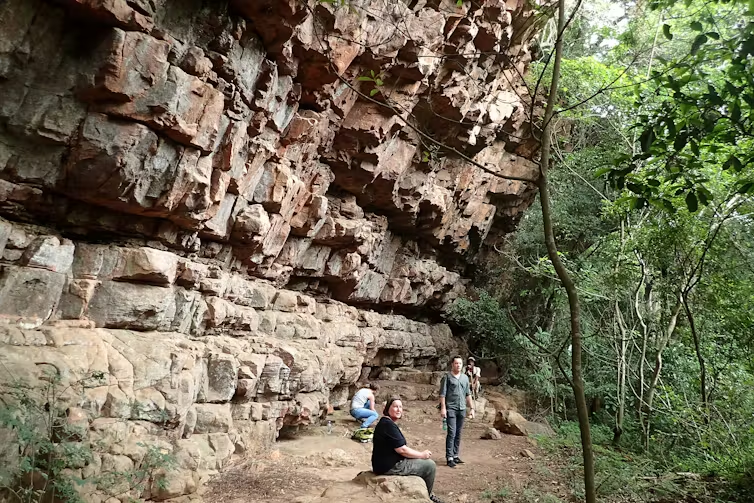The Shroud of Turin, a linen cloth revered by many as the burial shroud of Jesus Christ, has mystified scholars and believers alike for centuries. First unveiled in the 1350s, the shroud displays a faint image of a man, which has been the subject of intense debate regarding its origins and authenticity.
When it was initially presented, the Shroud was heralded as the actual burial cloth used to wrap the body of Christ after his crucifixion. The image on the shroud, depicting a bearded man with his arms crossed, was believed by many to be a miraculous imprint of Jesus himself. However, scientific research in the 1980s cast doubt on this claim, dating the fabric to the Middle Ages, long after Jesus lived.
Recent studies by Italian scientists, employing cutting-edge techniques involving x-rays, have reignited the debate by dating the shroud's material to around 2,000 years ago, a timeline consistent with the era of Jesus. This finding supports the theory that the bloodstained pattern on the shroud could indeed have been left by Jesus’ body after his crucifixion.
According to the Bible, Joseph of Arimathea wrapped Jesus’ body in a linen shroud and placed it in a tomb. The Gospel of Matthew (27:59–60) details this event, which has been a cornerstone of Christian tradition. The Shroud of Turin, since its first public display in the 14th century, has fascinated historians, religious leaders, skeptics, and the faithful alike. It has been preserved in the Cathedral of San Giovanni Battista in Turin, Italy, since 1578.
The cloth itself reveals faint, brownish images of a gaunt man, standing between 5'7" and 6' tall, with markings that correspond to the crucifixion wounds described in the Bible, including thorn marks on the head, lacerations on the back, and bruises on the shoulders. These details align with the biblical account of Jesus’ suffering, suggesting that the man depicted on the shroud endured similar torture.
In 1988, an international team of researchers performed carbon dating on a small fragment of the shroud, concluding that the fabric originated between 1260 and 1390 AD. This finding was based on the decay of carbon-14, a radioactive isotope, which led many to dismiss the shroud as a medieval forgery.
Nevertheless, some experts have continued to challenge this conclusion, arguing that the linen could be genuine. They point out that the shroud is made of flax, which was commonly grown in the Middle East, and that the image on the fabric bears a striking resemblance to the traditional depiction of Jesus, complete with a crown of thorns.
In the latest study, researchers from Italy’s Institute of Crystallography of the National Research Council applied a technique called wide-angle X-ray scattering (WAXS) to date the shroud. This method analyzes the natural aging of flax cellulose, converting it into a timeline from the fabric’s manufacture. The team examined eight small samples from the Shroud of Turin, using X-rays to reveal intricate details of the linen’s structure and the breakdown of its cellulose over time.
Cellulose, a component of plant cell walls, degrades at a measurable rate, providing insights into the age of the material. By assessing this degradation, the researchers estimated that the shroud was kept at a temperature of about 72.5 degrees Fahrenheit with 55 percent relative humidity for approximately 13 centuries before arriving in Europe. This analysis aligns the shroud’s origin with the first century AD, further supporting its authenticity.
The Bible states that, Joseph of Arimathea wrapped the body of Jesus in a linen shroud and placed it in a new tomb.
To validate their findings, the researchers compared the shroud’s cellulose degradation with that of other linens discovered in Israel dating back to the first century. They found that the data profiles were consistent with linen samples dated between 55 and 74 AD, such as those found at Masada, Israel, Herod's ancient fortress overlooking the Dead Sea.
Conversely, when the shroud’s degradation was compared with linens from the medieval period (1260–1390 AD), no similarities were found. The study concluded that to align the 1988 carbon dating results with the new findings, the shroud would have had to be preserved at an unusually high temperature throughout its supposed 700-year history—a scenario deemed highly unlikely.
Dr. Liberato De Caro, the study’s lead author, suggested that the 1988 carbon dating might have been flawed due to contamination that could not be entirely removed from the sample. He argued that carbon-14 dating is unreliable if the cleaning process is inadequate, which may have been the case in 1988. He also noted that there was a significant increase in carbon-14 concentration from the edges towards the center of the shroud, which could have skewed the dating results.
The Shroud of Turin remains one of the most studied and debated artifacts in history. Since the 1980s, over 170 peer-reviewed academic papers have examined the shroud, with many concluding that it is authentic. Earlier investigations in the 1970s explored whether the images were created by painting, scorching, or other means, but no definitive method was identified.
Further complicating the debate, in 2017, another team from the Institute of Crystallography found evidence of blood from a torture victim on the shroud, identifying substances like creatinine and ferritin, which are typically present in victims of severe trauma. These findings contradict the theory that the image was painted by medieval forgers.
As the scientific community continues to explore the mysteries of the Shroud of Turin, the debate over its authenticity endures. The recent discoveries add a compelling new dimension to this ancient puzzle, suggesting that the shroud may indeed date back to the time of Jesus and keeping alive the centuries-old quest to uncover the truth behind this enigmatic relic.









